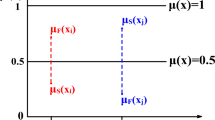Abstract
Based on the in-depth analysis of the essence and key features of vague phenomena, this paper focuses on establishing the axiomatical foundation of membership degree theory using for modeling vague phenomena, presents an axiomatic system to govern membership degrees and their interconnections. The concept of vague partition is introduced, on this basis, the concept of fuzzy set in Zadeh’s sense is redefined based on vague partition from the perspective of axiomatization. The thesis defended in this paper is that the mutual constraint relationship among vague attribute values in a vague partition should be the starting point to recognize and model vague phenomena by the quantitative analysis method.
Similar content being viewed by others
Change history
07 February 2018
I recently found that several errors occur in the statement of Definition 5.2 in Section 5 in the paper “Redefinition of the concept of fuzzy set based on vague partition from the perspective of axiomatization”.
References
Atanassov KT (1983) Intuitionistic fuzzy sets. VII ITKR’s Session, Sofia (deposited in Central Sci.-Technical Library of Bulg. Acad. of Sci., 1697/84) (in Bulgarian)
Atanassov KT (1986) Intuitionistic fuzzy sets. Fuzzy Sets Syst 20(1):87–96
Atanassov KT, Gargov G (1989) Interval valued intuitionistic fuzzy sets. Fuzzy Sets Syst 31(3):343–349
Bede B (2013) Mathematics of fuzzy sets and fuzzy logic. Springer, Berlin
Behounek L(2009) Logical foundations of fuzzy mathematics. Doctoral dissertation, Charles University in Prague, Prague, Czech. http://mujweb.cz/behounek/logic/papers/Behounek-PhD-summary.pdf
Cintula P, Hájek P, Noguera C (eds) (2011) Studies in logic: handbook of mathematical fuzzy logic, vol 37 and 38. College Publications, London
Dubois D, Prade H (2015) The legacy of 50 years of fuzzy sets: a discussion. Fuzzy Sets Syst 281:21–31
Dubois D, Prade H, Klement EP (1999) Fuzzy sets logics and reasoning about knowledge. Kluwer Academic, Dordrecht
Dvořák A, Novák V (2004) Formal theories and linguistic descriptions. Fuzzy Sets Syst 143(1):169–188
Goguen JA (1967) L-fuzzy sets. Math Appl 18:145–174
Goguen JA (1969) The logic of inexact concepts. Synthese 19(3–4):325–373
Grattan-Guinness I (1976) Fuzzy membership mapped onto intervals and many-valued quantities. Zeitschr. f. math. Logik und Grundlagen d. Math. Bd 22(1):149–160
Greenfield S (2016) Uncertainty measurement for the interval type-2 fuzzy set. In: Rutkowski L, Korytkowski M, Scherer R, Tadeusiewicz R, Zadeh L, Zurada J (eds) Artificial intelligence and soft computing (Lecture notes in computer science), vol 9692. ICAISC 2016. Springer, Cham
Hájek P (1998) Metamathematics of fuzzy logic. Kluwer, Dordrecht
Hu BQ, Kwong CK (2014) On type-2 fuzzy sets and their t-norm operations. Inf Sci 255(1):58–81
Hubbard DW (2010) How to measure anything: finding the value of intangibles in business, 2nd edn. Wiley, New York
Karnik NN, Mendel JM (2001) Operations on type-2 fuzzy sets. Fuzzy Sets Syst 122(2):327–348
Keefe BR, Smith P (1996) Vagueness: a reader. MIT Press, Cambridge
Klement EP, Mesiar R, Pap E (2000) Triangular norms. Springer, Berlin
Kolmogorov AN (1956) Foundations of the theory of probability (English edition). Chelsea Publishing Company, White River Junction
Mendel JM (2007) Advances in type-2 fuzzy sets and systems. Inf Sci 177(1):84–110
Novák V (2006) Which logic is the real fuzzy logic? Fuzzy Sets Syst 157(5):635–641
Novák V (2012) Reasoning about mathematical fuzzy logic and its future. Fuzzy Sets Syst 192:25–44
Novák V, Perfilieva I, Močkoř J (1999) Mathematical principles of fuzzy logic. Kluwer Academic, Dordrecht
Pan XD, & Xu Y (2016a) Vague partition. In: International conference on intelligent systems and knowledge engineering. IEEE
Pan XD, Xu Y (2016b) Vague membership measure: uncertainty modelling in knowledge engineering and decision making. In: Proceedings of the 12th international FLINS conference, pp 527–534
Pavelka J (1979) On fuzzy logic i: many-valued rules of inference, ii: enriched residuated lattices and semantics of propositional calculi. iii: semantical completeness of some many-valued propositional calculi. Math Logic Q 25(7–12):45–52, 1191–34, 447–464, 119–134
Peirce CS (1902) Vague. In: Baldwin JM (ed) Dictionary of philosophy and psychology. MacMillan, New York, p 748
Sadeghian A, Mendel J, Tahayori H (2013) Advances in type-2 fuzzy sets and systems: theory and applications. Springer, New York
Torra V (2010) Hesitant fuzzy sets. Int J Intell Syst 25:529–539
Ward M, Dilworth RP (1938) Residuated lattices. Proc Nat Acad Sci USA 24(3):162–164
Zadeh LA (1965) Fuzzy sets. Inf Control 8(3):338–353
Zadeh LA (1975) The concept of a linguistic variable and its application to approximate reasoning—1. Inf Sci 8:199–249
Zadeh LA (1978) Pruf-a meaning representation language for natural languages. Int J Man Mach Stud 10(4):395–460
Zadeh LA (2015) Fuzzy logic—a personal perspective. Fuzzy Sets Syst 281(C):4–20
Acknowledgements
The authors would like to express my warm thanks to Prof. P. Eklund and Prof. D.W. Pei for valuable discussions on some of the problems considered here, and are very grateful to the Editors and the anonymous reviewers for their insightful and constructive comments and suggestions that have led to an improved version of this paper. This work was partially funded by the National Natural Science Foundation of China (Grant Nos. 61305074, 61673320).
Author information
Authors and Affiliations
Corresponding author
Ethics declarations
Conflict of interest
The authors declare that they have no conflict of interest.
Ethical approval
This article does not contain any studies with human participants or animals performed by any of the authors.
Informed consent
Informed consent was obtained from all individual participants included in the study.
Additional information
Communicated by A. Di Nola.
A correction to this article is available online at https://doi.org/10.1007/s00500-018-3061-9.
Rights and permissions
About this article
Cite this article
Pan, X., Xu, Y. Redefinition of the concept of fuzzy set based on vague partition from the perspective of axiomatization. Soft Comput 22, 1777–1789 (2018). https://doi.org/10.1007/s00500-017-2855-5
Published:
Issue Date:
DOI: https://doi.org/10.1007/s00500-017-2855-5




